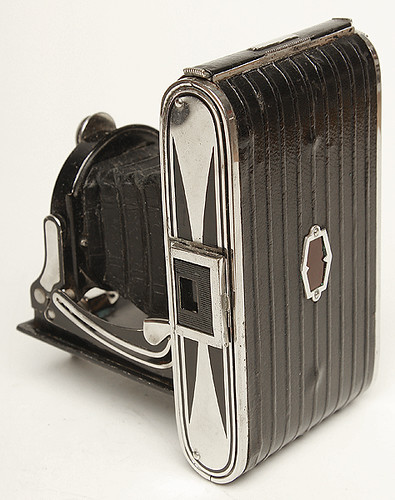Agfa Billy Zero

|
| image by Rick Soloway (Image rights) |
| |||||
| German, French & Italian Cameras using 127 film | |||||
| G e r m a n y |
3×4 | rigid | Dreivier | Futuro | Gewirette | Kolibri Parvola | Pupille | Ranca | Reporter | Puck | ||
| folding | Baby Ikonta | Baldi | Dolly | Goldi Gucki | Ingo | Korelle | Makinette Metharette | Perkeo | Vollenda | ||||
| 4x4 | Navax | Paxina Electromatic | Rothlar | ||||
| 4x6.5 | Bella | Billy | Bob | Dolly | Goldi Gucki | Korelle | Panta | Parvola Piccolette | Rio | Ultrix | ||||
| TLR | see German TLRs | ||||
| F r a n c e |
3×4 | rigid | Fotobaby | Lynx | Super-Boy | ||
| folding | Derby-Lux | Elax | ||||
| pseudo TLR | Auteuil | Longchamp | ||||
| 4×4 | rigid | Impera | Marly | Pari-Fex | Rubi-Fex | Top | |||
| 4×6.5 | rigid | Photo-Magic | |||
| I t a l y |
3x4 | Comet | Comet III | Cometa | Euralux Ibis | Maxima | Piccolo | Tanit | |||
| 4x4 | Comet | Euralux | Ibis | ||||
| 4x6.5 & other | Alfa | Delta | Relex | Rolet | Rondine | ||||
The Billy 0 (zero) is a small vertical folding camera, made by Agfa from c.1932 to 1937.[1] It makes eight pictures 4x6.5 cm on 127 roll film. It was exported to the USA as the V.P. Speedex or Speedex 0 (as in the Japanese advertisement, left).
The lens is either an f/5.6 Igestar anastigmat[2], in a dial-set Pronto shutter, as pictured right, or an f/3.9 Solinar (a Tessar-type) in a Compur. Either is focused by screwing the front element in and out.[3] On the example examined, with a Solinar, the focus scale is in feet, and is marked down to 7 feet, though the lens will turn considerably further. At least some of the cameras with the Igestar were scaled in metres (as reported in the discussion page of this article).
Like the Isolette folders, the Billy 0 is slimmer and more elegant than most cameras of its format, without being flimsy. The camera is decorated in an art deco style, with black enamel paint and bright plating on the flat sides, the strut mechanism (itself rather elegant), the film door catch and the table stand. The leatherette of the body and front is decorated with longitudinal ridges that emphasise the camera's slimness. The red window is not circular but an elongated hexagon. Even the film winding key is decorated, with an impressed pattern and knurled edge.[4]
Specifications
- Camera type: Vertically-oriented folding viewfinder camera. Self-erecting.
- Image format: 4x6.5 cm
- Film type: A-8 (127) roll film.
- Lenses offered:
- uncoated Igestar anastigmat 75 mm f/5.6 (in Pronto)
- uncoated Solinar 75 mm f/3.9 - 32 (in Compur)
- Shutters offered :
Both shutters have a socket for a cable release; neither is synchronised for flash.
- Viewfinder: Simple front and rear metal folding frame finder.
- Other features:
- ¼ inch tripod socket (on the same side as the winding key)
- Table stand on the front
- The Solinar will accept 30 mm push-on hood and filters (if notched to accommodate the infinity stop).
- Dimensions (height x width x depth): 122 x 73 x 30 mm; depth when unfolded 97 mm
- Weight: 380 g
Notes
- ↑ McKeown, James M. and Joan C. McKeown's Price Guide to Antique and Classic Cameras, 12th Edition, 2005-2006. USA, Centennial Photo Service, 2004. ISBN 0-931838-40-1 (hardcover). ISBN 0-931838-41-X (softcover). p.17-18.
- ↑ It seems likely that this lens name refers to Agfa's part in the Interessen-Gemeinschaft IG Farben, formed from several large German dye and chemical companies in 1926.
- ↑ As with several Agfa folders, the focusing thread on the Billy 0 is often stiff, because of old, dry grease.
- ↑ In the example examined, a spool of modern 127 film is a rather tight fit (in length, not diameter) in the film chamber; this makes advancing the film increasingly stiff toward the end of the film. This may be due to thicker, plastic flanges on modern 127 spools. The problem is relieved a little by lubricating the spool holders.
Links
- Agfa Speedex 0 review at Art Deco Cameras
- Agfa Billy Record and Billy 0 at The Fellsphoto Vintage Camera Collection (archived)

|
| Agfa Billy 0 with ensemble image by Tom O'Brien (Image rights) |

|
| Advertisement for Agfa products, Shashin Salon January 1934 (Image rights) |
